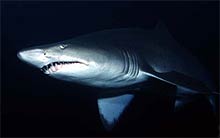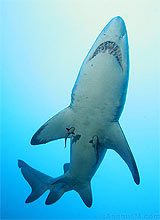Victoria: A Shark on the Critical List - The Grey Nurse Shark (Carcharias taurus)
Mark Rodrigue, MESA Victoria
Introduction
The Grey Nurse Shark is a worldwide species found in all states of Australia except Tasmania as well as in both tropical and cool water environments of the Pacific, Indian, and Atlantic Oceans.
Apart from occasional sightings in East Gippsland the Grey Nurse Shark is almost extinct in much of Victoria although it was once relatively widespread along Victoria’s coast. The Museum of Victoria holds a set of Grey Nurse Shark jaws in it’s collection that were taken from an animal caught in Port Phillip Bay.
An early Victorian scientific writer, Frederick McCoy refers to the Grey Nurse Shark as being ‘one of the largest and most ferocious of our Sharks, and so common as to be an object of great terror to bathers, who occasionally suffer grievous lacerations when caught swimming even near shore’. McCoy went on to state that the ‘Enormous jaws of this species may often be seen in the fishermen’s huts along the shore from Picnic Point to Mordialloc’. Governments of that period offered a reward to fishermen based on the length of each Grey Nurse Shark killed.
|

Image courtesy © Ken Hoppen,
oceannotions@primus.com.au ) |
In Australia there are two major populations of Grey Nurse Sharks found on opposite coasts with the east coast population listed as critically endangered and the west coast population is listed as vulnerable under the Environmental Protection and Biodiversity Conservation Act.
Grey Nurse Sharks are now protected under Fisheries Legislation in New South Wales , Western Australia , Victoria , Tasmania and Queensland . This species became the first protected shark in the world when the NSW Government declared it a protected species in 1984. A national recovery plan for the conservation of this species has been developed which provides directions for protecting the remaining populations of this shark species.
Despite the protection given to these animals, populations along the East Australian coastline have fallen to dramatically low levels over the last few decades with numbers in NSW being estimated now to be as low as 292 individual animals remaining. There are concerns that the east coast population has fallen so low that individual animals may now not be able to successfully find a mate and breed.
Globally, the species is listed as Vulnerable in the IUCN Red List of Threatened Animals in March 2000. They are also fully protected in South Africa , Namibia and Florida (USA).
|
The Grey Nurse Shark is a scary looking shark with a full set of pointed teeth that protrude from the animal’s mouth. It is these teeth that have given rise to the common misconception that these sharks are dangerous “man –eaters”. In spite of its appearance the species is not a threat to divers or swimmers unless provoked. Many shark attacks in Australia have been attributed incorrectly to the Grey Nurse Shark often due to its fierce appearance.
The reality is far different with scientists and divers now realising that this species of shark largely feeds on fish. The jagged inward curved pointy sharp teeth are ideal for capturing and holding slippery fish. These are quite different to the triangular teeth with serrated edges seen in the teeth of large predator sharks such as the Great White and Tiger Sharks.
Unfortunately public opinion towards the Grey Nurse Shark has not been kind and apart from the rewards given to kill these sharks in the 1800s, Grey Nurse Shark continued to be targeted for spear fishing and hunting. As Grey Nurse Sharks often congregate in groups in rock gutters they have been relatively easy to find and kill.
|

Notice the teeth
Image courtesy Aengus Moran |
| |
|

Grey nurse shark
(courtesy of Richard Barnett via Flickr)
|
During the 1950s and 60s there was a determined effort among spear fishers to wipe out Grey Nurse Sharks along the NSW coastline. Close to 300 Grey Nurse Sharks were taken once the use of powerheads, a type of spear with an explosive head, became widespread in skin diving circles.
One author in the 1970s noted the taking 24 grey nurse from a single gutter at Seal Rocks and reflected that the Grey Nurse Shark would soon become rare as a consequence of the introduction of powerheads. Unfortunately 30 years on this has become the reality that sees this shark species listed as Critically Endangered on the east coast of Australia.
Today people are keen to dive and observe these magnificent creatures and they often pay a lot of money to see these sharks in their natural environments.
|
next ...
|
|




